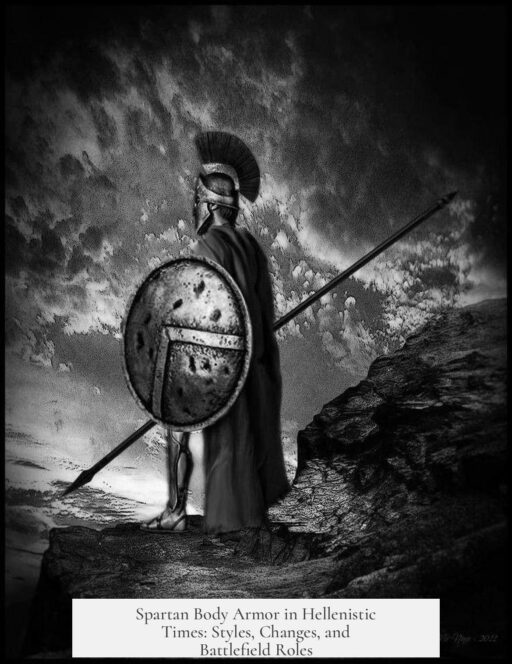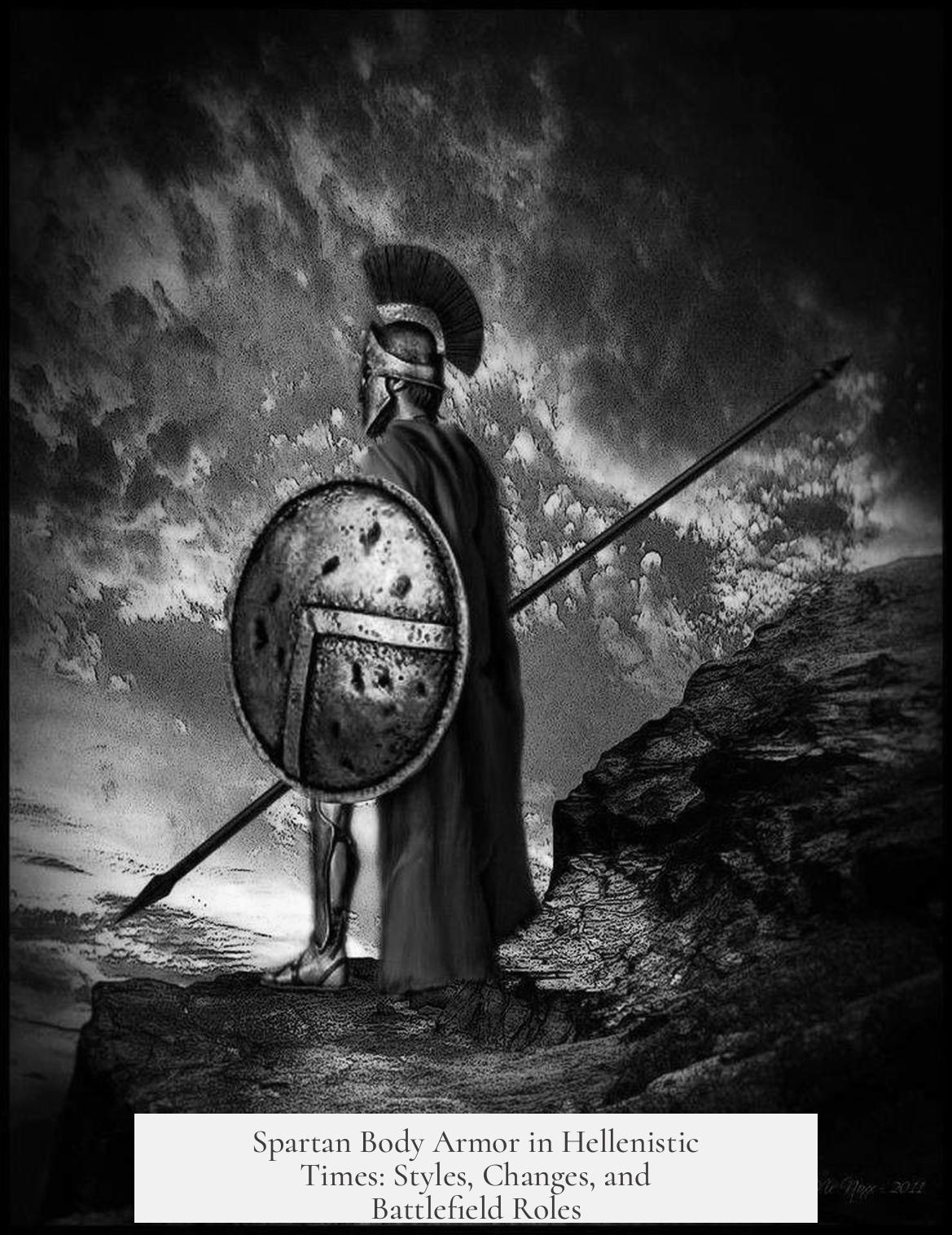During Hellenistic times, Spartan warriors adopted a distinct style of body armor characterized by a shift from the Classical hoplite gear to Macedonian-style equipment, particularly following the reforms of Kleomenes III in the 230s BC.
The Hellenistic period (323–31 BC) follows the death of Alexander the Great. This era differs markedly from the Classical period (490–323 BC), during which Sparta was prominent with its heavy hoplite infantry. When discussing Spartan armor, it is crucial to distinguish these periods because Spartan military gear evolved significantly.
Before Kleomenes III, Spartan warriors largely mirrored the typical Greek hoplite armor. Initially, hoplites wore bronze cuirasses, greaves, and face-covering helmets, marking their elite status. By the 5th century BC, however, hoplites began reducing heavy armor. Linen cuirasses gained popularity, and many discarded armor entirely, relying instead on their large aspis shields and helmets like the simple conical pilos. Spartan hoplites followed this trend and, according to Thucydides’ account of the battle of Sphakteria, often fought with only pilos helmets and minimal armor during the Peloponnesian War.
One defining Spartan feature was uniformity in equipment rather than quantity of armor. By the late 5th century BC, Spartan warriors displayed identical bronze-plated shields with the lambda (Λ) symbol, representing Lakedaimon. They also wore a red garment known as the phoinikis, dyed using Phoenician red dye. This red tunic or cloak, combined with polished bronze gear, created a visually intimidating fighting force. Xenophon described Spartan hoplites as a “single mass, all bronze, all scarlet,” emphasizing their disciplined and uniform appearance over heavy protective gear. The red and bronze ensemble was likely designed to intimidate enemies rather than provide additional protection. This era saw minimal use of cuirasses, highlighting the absence of heavy body armor.
The reforms of Kleomenes III in the 230s BC marked a substantial change in Spartan military equipment. These reforms transformed the remnants of classical hoplite formations into Macedonian-style pikemen, known as sarissophoroi. According to Plutarch’s Life of Kleomenes, these new Spartan pikemen abandoned their large round aspis shields in favor of smaller Macedonian-style shields, suspended by a neck strap.
- These pikemen wielded long pikes (sarissas) with both hands.
- They likely adopted heavier armor, such as bronze chestplates and greaves, aligning with the trend in contemporary Macedonian-style armies.
- The smaller shield improved maneuverability alongside pike formations but offered less individual protection compared to the classic aspis.
The Hellenistic pikemen’s armor differed from earlier Spartan gear by emphasizing protection suitable for the dense phalanx formation. This shift aligned Spartan military organization and equipment closer to Macedonian models, unlike the lightly armored hoplites of the Classical period.
Outside these heavy infantry types, Spartan light troops generally wore no armor. Cavalry units, particularly in the Classical era, often wore open-faced helmets like the Boiotian helmet and did not carry shields, reflecting their mobility role rather than direct melee combat.
| Period | Spartan Armor Characteristics | Key Features |
|---|---|---|
| Classical Period (before 323 BC) | Bronze cuirasses early, then linen or no body armor | Large aspis shields, pilos helmets, greaves, red phoinikis garment, lambda shield emblem |
| Hellenistic Period (post-Kleomenes III reforms, 230s BC onward) | Macedonian-style gear; pikes, smaller shields, heavier armor possible | Smaller crescent shields on neck straps, sarissa pikes, likely bronze chestplates and greaves |
Sources confirm that the classic Spartan image of heavily armored hoplites persisted chiefly in the cultural memory rather than practice during the Hellenistic era. Kleomenes III’s reforms mark a pivotal turning point, reflecting evolving warfare tactics and equipment needs.
- Spartans initially used thick bronze armor, gradually reducing it in favor of lighter linen and fewer protections.
- Uniform visual identity—red garments and lambda shields—was crucial during the Classical period for intimidation.
- Kleomenes III’s 230s BC reforms introduced Macedonian-style pikes and smaller shields, raising the likelihood of reintroducing heavier armor pieces.
- Hellenistic Spartans adapted to contemporary military trends through equipment and tactical reforms.
What Kind of Body Armor Did Spartan Warriors Wear in Hellenistic Times?
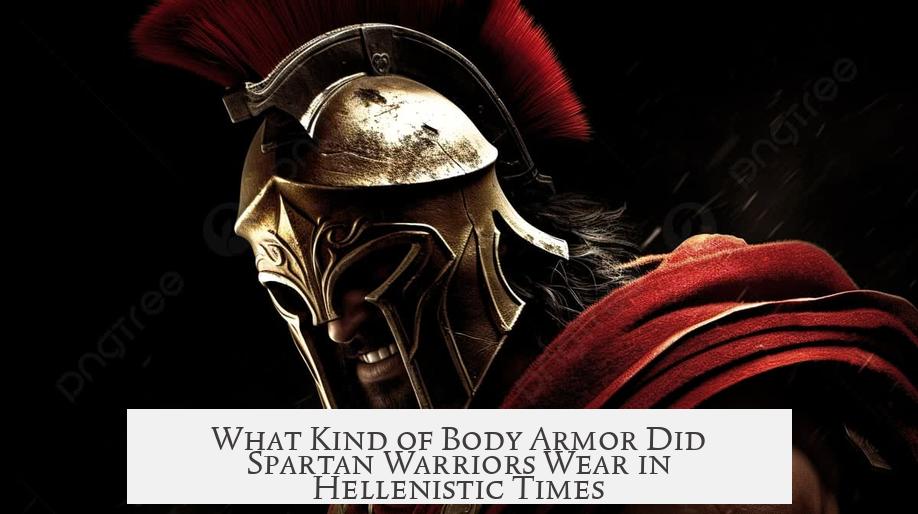
The Spartan warriors of Hellenistic times wore body armor that evolved dramatically, influenced by military reforms and changing warfare tactics. Their armor shifted from the traditional Classical-style hoplite gear to a more Macedonian-style pike infantry ensemble under Kleomenes III, involving smaller shields and likely heavier armor pieces.
Let’s unpack this fascinating transformation of Spartan body armor during the Hellenistic period, roughly from 323 to 31 BC. Understanding the details helps appreciate how one of history’s most iconic warrior cultures adapted to new forms of combat.
Understanding the Time Period: Classical vs. Hellenistic Sparta
Sparta’s armor didn’t remain static through the centuries. When discussing Spartan warriors, it’s crucial to clarify the historical frame. The “Hellenistic period” runs from Alexander the Great’s death in 323 BC until the Battle of Actium in 31 BC. Before this, the Classical period (around 490-323 BC) marks Sparta’s peak prominence, including its role in the Persian and Peloponnesian Wars.
Our primary evidence about Spartan armor is sparse for both periods, but a key distinction exists because of reforms in the 230s BC under King Kleomenes III. He introduced a major change by turning the classic Spartan hoplites into Macedonian-style pikemen, changing their equipment fundamentally.
Pre-Kleomenes III Armor: The Classical Spartan Look
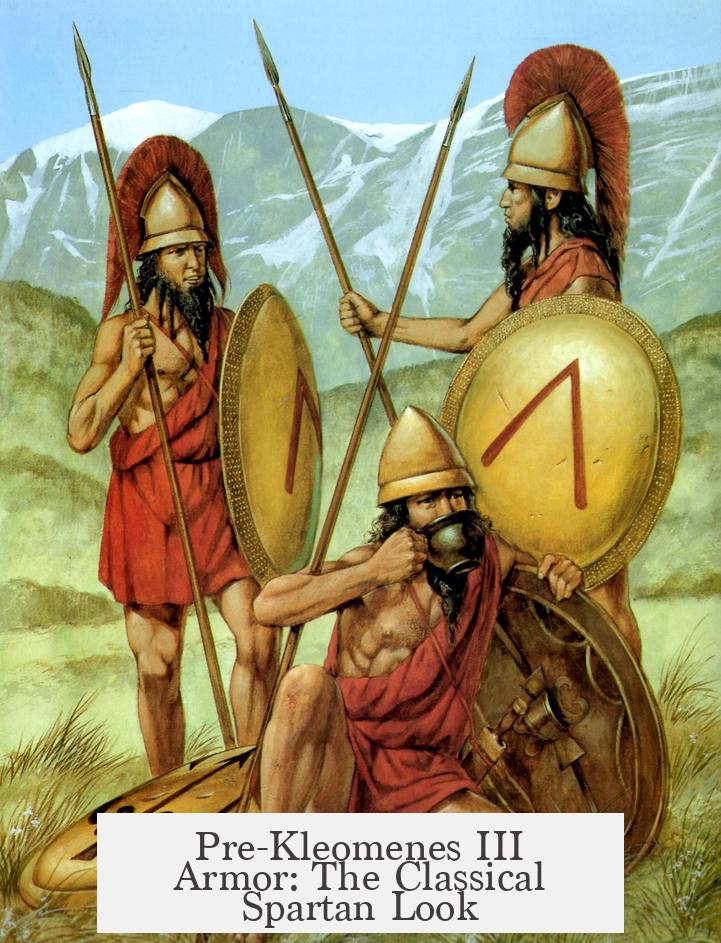
Before those reforms, Spartan warriors resembled their fellow Greek hoplites in armor and armament. Early hoplite armor favored bronze gear—cuirasses (chestplates), face-covering helmets, and greaves (shin guards). These bronze pieces symbolized both protection and status.
Yet, as warfare evolved, hoplites increasingly abandoned heavy bronze armor. By the 5th century BC, lighter armor became the norm. They shifted to glued or quilted linen cuirasses, which were common during the Persian Wars. This trend towards shedding armor accelerated.
By the Peloponnesian War, Spartan hoplites mostly wore a simple conical helmet known as the pilos, occasionally accompanied by greaves, but rarely donned full body armor. Shields became their primary defense. Evidence from Thucydides’ account of the Battle of Sphakteria indicates Spartans there wore only pilos helmets with minimal additional armor.
Light troops generally went without armor, while cavalrymen could be more heavily armored but used open-faced helmets such as the Boiotian type, fighting without shields.
What Set Spartans Apart: Uniformity over Quantity
Spaartan warriors didn’t impress because they wore the heaviest armor—far from it. Their power came from uniformity. By the late 5th century BC, Spartans and their allies carried matching bronze-plated shields prominently featuring the lambda (Λ), the symbol of Lakedaimon, Sparta’s region.
Additionally, Spartans wore a piece of red clothing called the phoinikis. This item, dyed with Phoenician red dye, may have been a tunic or cloak—debated among scholars—but it enhanced their intimidating battle presence. Imagine the glint of bronze shields coupled with a sea of scarlet-clad soldiers advancing as one solid mass, according to Xenophon.
Intriguingly, the lack of cuirasses maintained the visibility of this red uniform. If full chest armor hid their signature red, Spartans risked losing a vital psychological edge against their enemies.
These uniform colors and shield emblems first appeared during the Peloponnesian War, and there’s no evidence Spartans used them earlier in the Persian Wars, or ancient historians like Herodotus would likely have mentioned it.
Reforms of Kleomenes III: Change to Macedonian-Style Pikemen
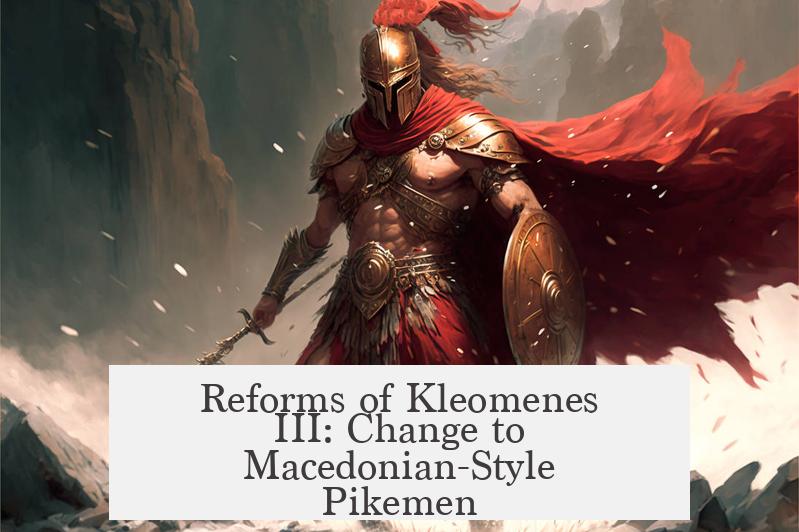
Fast forward to the 230s BC, when Kleomenes III introduced sweeping military reforms. This was a game-changer. He converted Sparta’s remaining Classical-style hoplites into Macedonian-style pikemen, equipped with long pikes wielded in both hands.
This shift meant abandoning the iconic large round aspis shields for smaller Macedonian shields carried by a strap around the neck. While ancient sources like Plutarch don’t explicitly mention changes in body armor, trends in Hellenistic warfare suggest these pikemen carried heavier armor compared to previous Spartan hoplites.
It’s reasonable to believe that chestplates and greaves, likely made of bronze or lighter metals, were reintroduced to offer better protection. After all, pikemen often marched shoulder to shoulder in dense formations, making lighter armor insufficient in close conflict.
Body Armor in Context: Protective Gear and Battlefield Realities
Do you picture Spartans as bronze giants armored top to toe? Well, they weren’t always. Military gear is a balance between protection, weight, mobility, and cost. In the Classical era, Spartans gradually dropped heavy bronze armor, favoring speed and flexibility in the phalanx formation.
However, the rise of Macedonian warfare under Philip II and Alexander the Great emphasized longer reach with pikes. This made heavy armor more desirable to protect against spear thrusts and infantry engagements. So, Spartans adapting to Macedonian tactics under Kleomenes III likely revisited the use of chestplates and greaves as practical necessities.
Visual Impact of Spartan Armor Beyond Protection
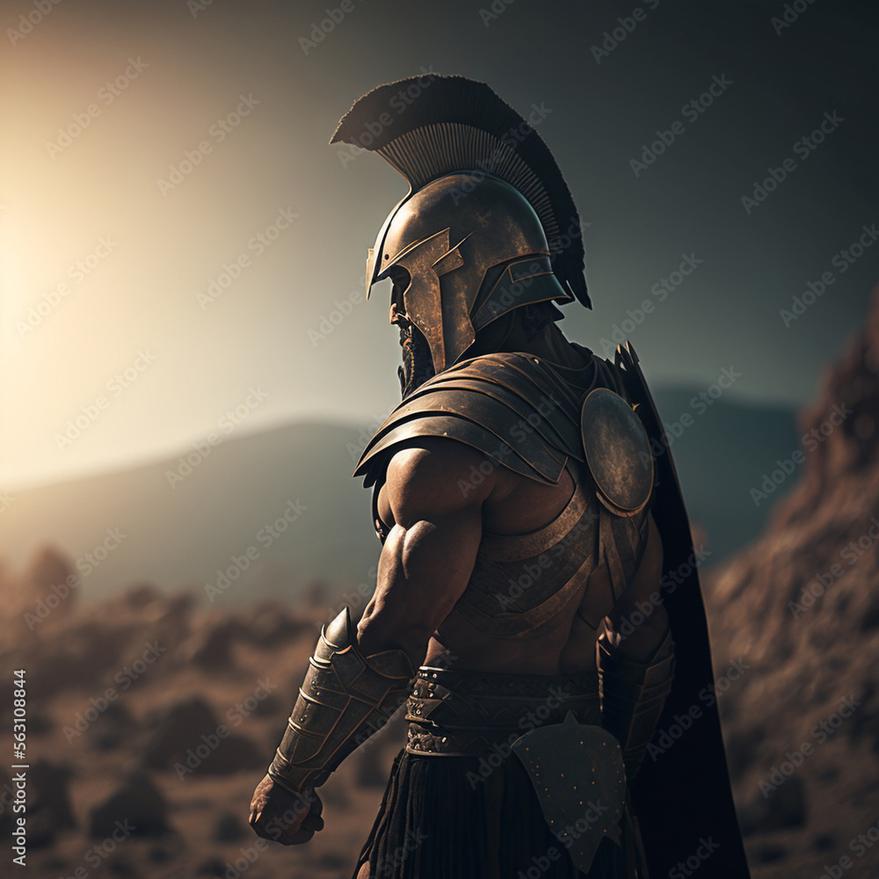
It’s interesting to note how much the Spartans relied on uniformity and visual intimidation. Their bronze-plated lambda shields and red phoinikis clothing conveyed cohesion and discipline, which could demoralize foes even before the first clash.
Could the sight of an entire Spartan infantry flashing bronze and scarlet have affected their enemies more than their actual armor thickness? Quite possibly. Psychological warfare wasn’t an ancient Spartan invention, but they were masters at it.
Summary and Takeaways
- Classical Spartan hoplites wore bronze helmets, cuirasses, and greaves early on, gradually shedding heavy armor for lighter linen and helmets like the pilos.
- Spartans stood out through uniformity—wielding lambda shields and wearing red phoinikis garb, creating a striking battlefield presence.
- Hellenistic reforms under Kleomenes III transformed Spartan hoplites into Macedonian-style pikemen, replacing large shields with smaller Macedonian ones and probably reintroducing heavier armor pieces like chestplates and greaves.
- The changing face of warfare required Spartans to adapt, balancing protection, mobility, and psychological impact.
So, the body armor Spartan warriors wore in Hellenistic times was a dynamic and evolving kit, reflecting broader military and cultural shifts. They began in heavy bronze gear, moved to minimal armor but high uniformity, and ultimately embraced heavier protective gear again as pikemen under Macedonian influence.
Isn’t it fascinating how even the toughest warriors had to adapt their gear to survive? The Spartans’ story reminds us that fighting traditions evolve with changing times, balancing identity, utility, and innovation.
What body armor did Spartan warriors wear during the Hellenistic period?
Spartans in the Hellenistic period, especially after reforms in the 230s BC, shifted to Macedonian-style pikemen. They likely wore heavier armor again, including chestplates and greaves, but not the large classical round shields.
How did Kleomenes III change Spartan armor and equipment?
Kleomenes III replaced the large round aspis shields with smaller Macedonian shields. His troops used long pikes and possibly returned to wearing protective pieces like chest armor and greaves, reflecting trends of the time.
What armor did Spartans wear before the Hellenistic reforms?
Before the reforms, Spartans wore bronze cuirasses, helmets, and greaves early on. Over time, they reduced armor, often wearing just a pilos helmet, greaves, and a large lambda shield.
What made Spartan armor distinct compared to other Greek hoplites?
Spartan armor was uniform across the army, featuring bronze-plated lambda shields and red clothing called the phoinikis. This uniform look gave Sparta a unique and intimidating presence on the battlefield.
Did Spartan hoplites wear body armor during the Peloponnesian War?
By the Peloponnesian War, most Spartans wore no cuirasses and relied on their distinctive red garments and helmets for protection, along with their large lambda shields.
